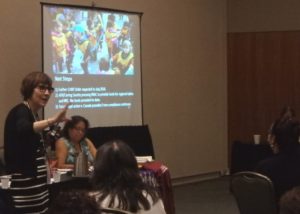Anishinaabe Kwe leading the way on child protection

By Laura Robinson
NIAGARA FALLS—Anishinabek Nation’s Social Services Director Adrienne Pelletier and education negotiator Tracy O’Donnell teamed with Child and Family Caring Society founder Cindy Blackstock at the Niagara Falls Assembly of First Nations (AFN) on July 13, as they outlined the latest progress on the rights of children.
Pelletier and O’Donnell’s work encompasses the creation of and implementation strategy for the Anishinabek Nation Child Well-being Law, while Blackstock committed years ago to a long-time fight for the rights of First Nation children. In January 2016, she was successful at the Canadian Human Rights Tribunal (CHRT) which recognized that funding for First Nation children can be up to 38% less than what is awarded to non-First Nation children.
Pelletier and O’Donnell took the standing-room-only-audience through the multi-year consultative process they commenced in 2007.
“We said to ourselves ‘we’re at a cross-roads’,” said Pelletier, referring to the inordinate amount of First Nation children in care. “We have to stand up and just do it,” she added. And so they did, traveling the territory, staying with friends and family as they asked communities what a traditional childcare model looks like, how that model would best be implemented, and for a commitment to seeing this through from all with whom they consulted.
The law has travelled much ground since the two women were hoping a tank of gas would last longer than the snowstorm. “We’re moving quickly now,” said Pelletier, “and want to establish the well-being law as fully functioning by 2018.”
This law, first and foremost, acknowledges, respects, and is designed to ensure the safety and well-being of children and youth within families and communities. It would provide real support to those families and communities so they can safeguard children and youth in the multitude of ways necessary, the result of which would ensure that children are able to stay within their community when being identified as needing care.
“We want to keep children who need protection in our communities,” stated Pelletier. “We need to stop this industry of ‘child protection.’ We didn’t ask the feds or the province for permission to create a law—we just did it.”
Earlier this year, “a negotiated framework agreement with the Ministry of Child and Youth Secretariat” had already been requested by Gary Dokis, Chief Operating Officer at Union of Ontario Indians (UOI), who was representing Grand Chief Madahbee at the province’s Standing Committee on Economic Affairs. Dokis requested that the province “transfer all child-welfare authorities to Anishinabek Nation by April 11, 2017.” Gone would be the institutionalized practice of an outside social worker administering a program that so often removes children from their communities and support groups. This practice too frequently isolates the child or youth culturally, spiritually, socially, and even physically, as young people in care can be stuck in hotels and motels in unsafe neighbourhoods and urban environments.
Instead, the Child Well-being Law recognizes that sometimes parents or guardians are unable to care for children and youth and may be unlikely to do so in the future, and therefore understands that it is the community’s responsibility to care for all children while maintaining traditions, culture, values, and language.
The October 2015 change in the federal government has meant the province, which supports the changeover, according to Pelletier, has been able to move forward.
“We’ve been able to secure new funding with Ontario and Canada,” she said. “We’re building a prevention focused funding framework. There is a direct relationship often between poor housing and poverty and kids being apprehended; kids shouldn’t be apprehended because they live in poverty. Addressing poverty is an example of preventing these situations.”
Blackstock gave an update on the January 2016 CHRT win. There was not a lot of good news. “The tribunal ordered immediate remedies,” said Blackstock, but, she added, the March federal budget did not reflect the amount of funds ordered by the tribunal, nor was there a plan that reflected the “immediate” nature of the order. The Caring Society estimated $200 million was needed immediately, but the actual amount received translated into a shortfall of $129 million.
On July 6; however, a week before the AFN assembly, Indigenous Affairs and Health jointly announced an additional $382 million would be provided so Jordan’s Principle could be realized. This would always ensure First Nations children always have equal access to health care without jurisdictional provincial and federal disputes. It was named Jordan’s Principle after Jordan River Anderson, a five-year-old boy who died in hospital while the federal government and Manitoba (provincial government) fought in Court over who should pay his health costs.
But Blackstock says the way in which they arrived at this number is opaque, as is the formula that will be used in its allocation. Most importantly though, is that the ministries mentioned health care and social services, but the CHRT order included education and other government services to be “immediately” funded and the situation rectified. “Children in care are more likely to experience mental health issues and additional other problems. Where is the support for them?” she asked. “This isn’t about fairness to governments,” said Blackstock, “it’s about fairness to kids.”
Participants in the session from British Columbia to the east coast gave examples of how children were taken away, how powerless they felt in the process, and how foster-care so often led to incarceration.
Anishinabek Nation was thanked, as was Blackstock, for providing a model for others. A Mi’kmaq man noted, “We are helping the parent to become a better parent. I want to thank you Anishinabek ladies for doing what you are doing.”


